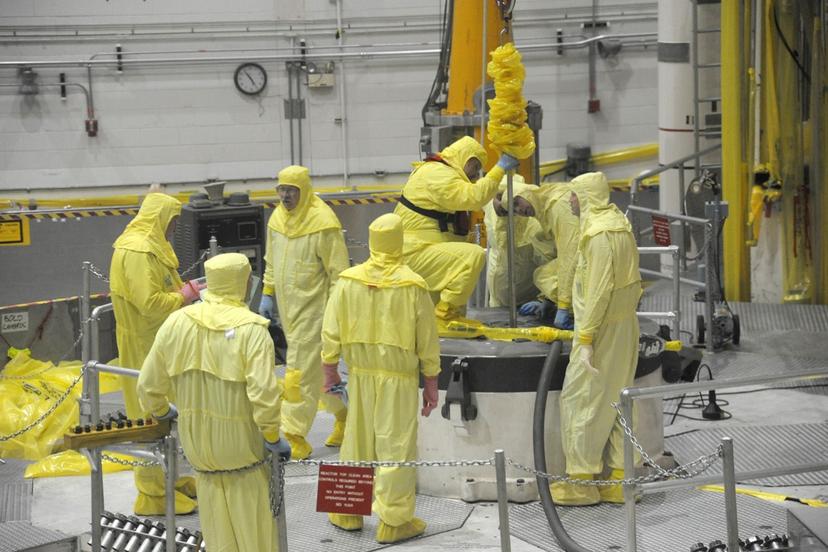Nuclear Power

Structure
Nuclear power is energy released in large amounts by the splitting or formation of atomic nuclei. The light and heat of the sun and other stars are examples of naturally occurring nuclear energy. Artificially produced nuclear energy can be released in a steady, controllable manner in devices called nuclear reactors.
In nuclear power plants, the fuel used is uranium, which undergoes a fission reaction, or atom splitting, that produces tremendous quantities of heat. Water circulated through a reactor carries the heat away, in the form of steam under very high pressure, through pipes to drive the turbines that produce electricity in the same way as a conventional power plant.
The reactor also includes channels through which cooling water circulates and other empty spaces where control rods can be inserted. A control rod contains material that absorbs the released neutrons, thus preventing some fission reactions from occurring. When control rods are inserted into the reactor, they reduce the number of atoms being split, causing the reactor to cool down and generate less heat. When the control rods are withdrawn, the reaction rate speeds up and the reactor gets hot and generates more heat. Thus, the power in a nuclear-fueled electrical power plant is controlled by moving the control rods in and out of the reactor.
The area of the reactor where the fission takes place is called the core, and it is contained within the reactor vessel, lined by a thick inner shell of steel to keep the heat in the system and under control. This internal shield is surrounded in turn by several feet of concrete insulation that serves as a nuclear radiation shield to protect personnel and the surrounding area from radiation. The radiation is very harmful to the human body when absorbed in sufficient quantities.
In addition to the immediate radiation produced by fission, the fission process and the bombardment of materials by neutrons create a variety of both gaseous and solid radioactive materials. Some of these materials emit intense radiation, and some remain radioactive for a very long time. Most reactors are housed in a steel-lined concrete structure called the containment building, whose purpose is to contain radioactive materials should an accident release them from the reactor.
A serious problem associated with the use of nuclear energy is the handling, treatment, and disposal of the solid, liquid, and gaseous radioactive waste products it creates. Several methods for the long-term disposal of highly radioactive wastes have been developed and studied. The most widely accepted plan consists of binding the wastes in a glass-like or ceramic substance that is resistant to corrosion. This waste material would be placed deep underground in stable geological formations where it would remain undisturbed. Meanwhile, until long-term plans are agreed upon, radioactive wastes are being held in temporary storage, typically in containers held in pools of water near nuclear plants. The water carries away the heat produced by radioactive decay and serves as a shield against the radiation they emit.
The nuclear power industry employs skilled and highly trained workers to maintain and assure the operating safety of nuclear facilities, including facility operators, engineers, and technicians.
Nuclear engineers research and design the different processes and equipment used in nuclear systems. They also often monitor nuclear power facilities to assure the equipment is operating properly and that practices implemented adhere to strict federal safety regulations and laws.
Nuclear technicians assist engineers and other professionals in nuclear research and production. Technicians fall into two categories: operating technicians, who monitor the performance of nuclear power plants under the supervision of nuclear reactor operators and engineers; and radiation protection technicians, who monitor radiation levels at nuclear power plants to protect employees, the facilities, and the surrounding area form radiation contamination. Some technicians work in nuclear waste management and treatment facilities and perform duties similar to those of radiation protection technicians at power plants, but they monitor the disposal, recycling and storage of nuclear waste materials.
Nuclear power reactor operators manage nuclear facilities by adjusting control rods, which affects how much electricity a reactor generates. In addition, they monitor reactors, turbines, generators, and cooling systems, making adjustments to controls as necessary. They monitor all facility operations, watching for problems and should any arise, determining the cause and solutions. Reactor operators must be licensed by the federal Nuclear Regulatory Commission, pass regular medical testing, may undergo testing for drugs and alcohol use, and must complete continuing education programs to keep their skills up to date.
